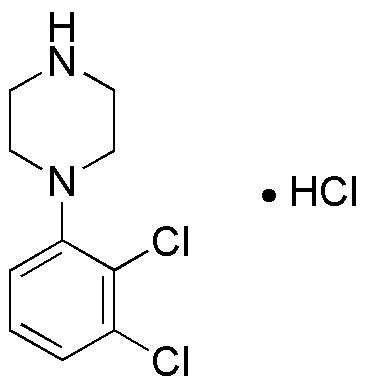1-(2,3-dichlorophenyl)piperazine hydrochloride is widely utilized in research focused on:
- Pharmaceutical Development: This compound serves as a key intermediate in the synthesis of various pharmaceuticals, particularly in the development of antipsychotic and antidepressant medications, enhancing therapeutic options for mental health disorders.
- Neuroscience Research: It is used in studies examining neurotransmitter systems, providing insights into brain function and the mechanisms of psychiatric conditions, which can lead to improved treatment strategies.
- Analytical Chemistry: The compound is employed in analytical methods to detect and quantify piperazine derivatives in biological samples, aiding in pharmacokinetic studies and drug monitoring.
- Material Science: Researchers explore its potential in developing novel materials with specific electronic or optical properties, contributing to advancements in technology and materials engineering.
- Environmental Studies: It is investigated for its behavior and degradation in environmental settings, helping to assess the impact of pharmaceutical pollutants and inform regulatory practices.
Informations générales
Propriétés
Sécurité et réglementation
Applications
1-(2,3-dichlorophenyl)piperazine hydrochloride is widely utilized in research focused on:
- Pharmaceutical Development: This compound serves as a key intermediate in the synthesis of various pharmaceuticals, particularly in the development of antipsychotic and antidepressant medications, enhancing therapeutic options for mental health disorders.
- Neuroscience Research: It is used in studies examining neurotransmitter systems, providing insights into brain function and the mechanisms of psychiatric conditions, which can lead to improved treatment strategies.
- Analytical Chemistry: The compound is employed in analytical methods to detect and quantify piperazine derivatives in biological samples, aiding in pharmacokinetic studies and drug monitoring.
- Material Science: Researchers explore its potential in developing novel materials with specific electronic or optical properties, contributing to advancements in technology and materials engineering.
- Environmental Studies: It is investigated for its behavior and degradation in environmental settings, helping to assess the impact of pharmaceutical pollutants and inform regulatory practices.
Documents
Fiches de données de sécurité (FDS)
La FDS fournit des informations de sécurité complètes sur la manipulation, le stockage et l’élimination du produit.
Spécifications du produit (PS)
Le PS fournit une description complète des propriétés du produit, notamment sa composition chimique, son état physique, sa pureté et les exigences de stockage. Il détaille également les plages de qualité acceptables et les applications prévues du produit.
Certificats d'analyse (COA)
Recherchez des certificats d'analyse (COA) en saisissant le numéro de lot du produit. Les numéros de lot et de lot se trouvent sur l'étiquette d'un produit, après les mots « Lot » ou « Lot de fabrication ».
Numéro de catalogue
Numéro de lot/série
Certificats d'origine (COO)
Ce certificat d'exploitation confirme le pays dans lequel le produit a été fabriqué, et détaille également les matériaux et composants utilisés et s'il est issu de sources naturelles, synthétiques ou autres sources spécifiques. Ce certificat peut être requis pour les douanes, le commerce et la conformité réglementaire.
Numéro de catalogue
Numéro de lot/série
Fiches de données de sécurité (FDS)
La FDS fournit des informations de sécurité complètes sur la manipulation, le stockage et l’élimination du produit.
DownloadSpécifications du produit (PS)
Le PS fournit une description complète des propriétés du produit, notamment sa composition chimique, son état physique, sa pureté et les exigences de stockage. Il détaille également les plages de qualité acceptables et les applications prévues du produit.
DownloadCertificats d'analyse (COA)
Recherchez des certificats d'analyse (COA) en saisissant le numéro de lot du produit. Les numéros de lot et de lot se trouvent sur l'étiquette d'un produit, après les mots « Lot » ou « Lot de fabrication ».
Numéro de catalogue
Numéro de lot/série
Certificats d'origine (COO)
Ce certificat d'exploitation confirme le pays dans lequel le produit a été fabriqué, et détaille également les matériaux et composants utilisés et s'il est issu de sources naturelles, synthétiques ou autres sources spécifiques. Ce certificat peut être requis pour les douanes, le commerce et la conformité réglementaire.


